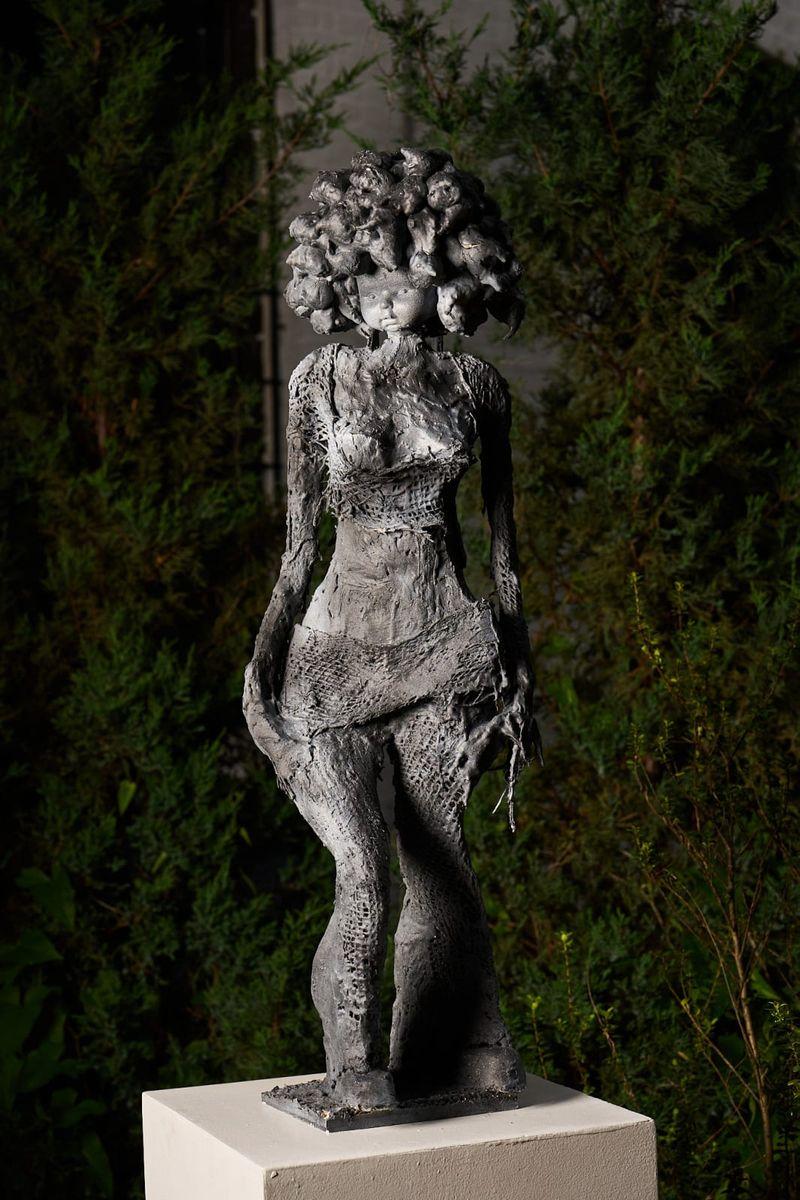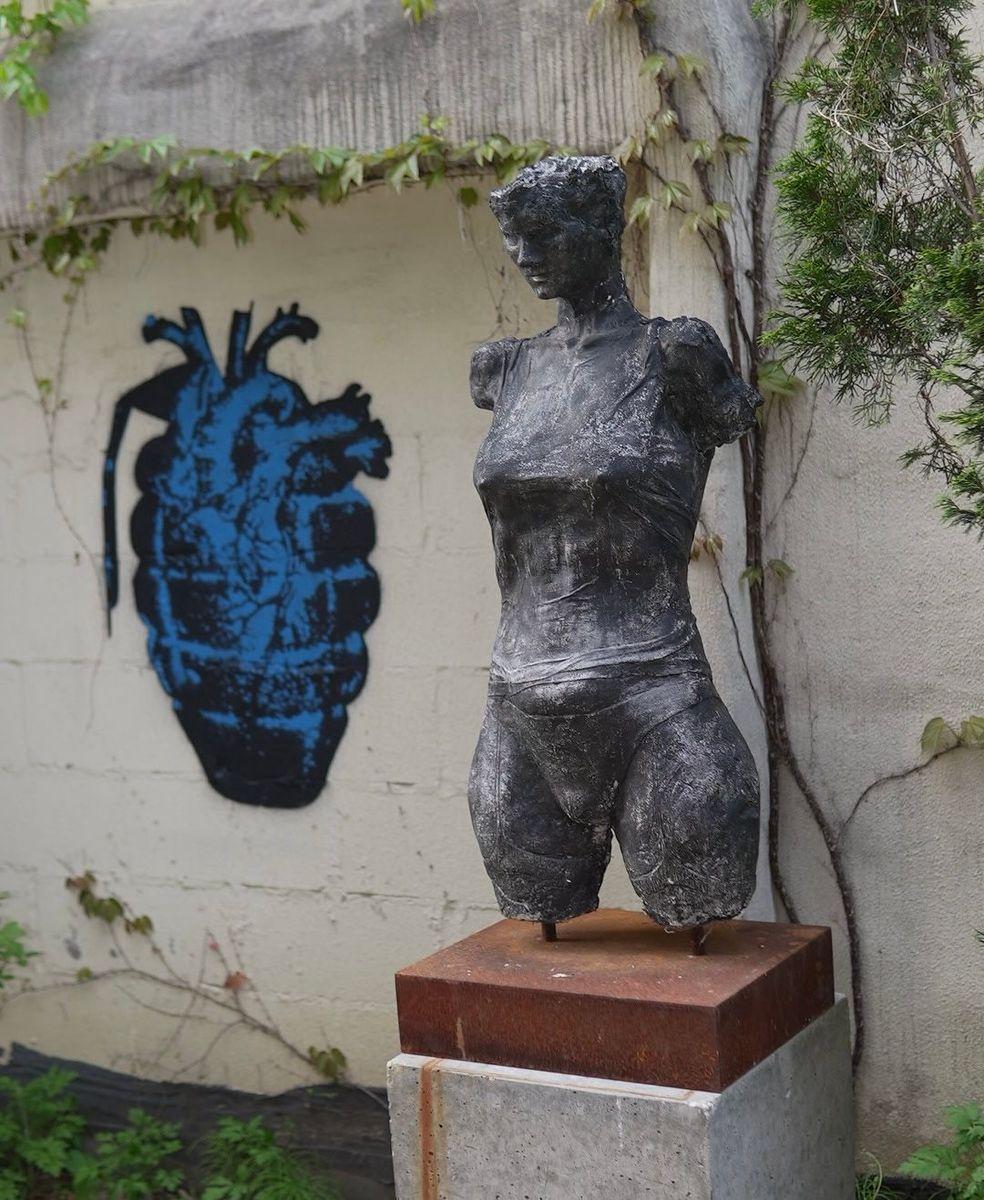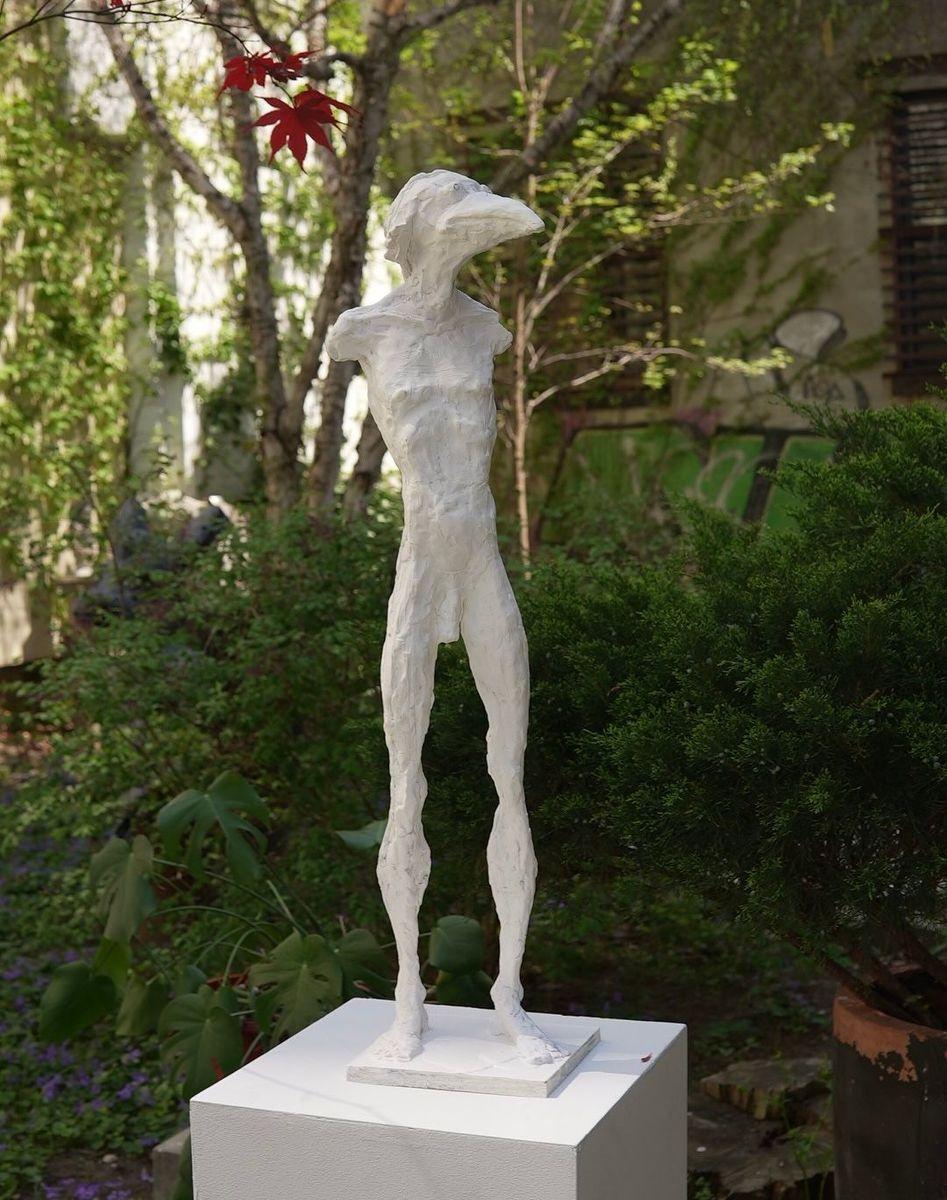Twelve Chairs Gallery is a contemporary art space founded by Kristine Stasiulevich and Zura in the vibrant heart of Williamsburg, Brooklyn. Dedicated to original and expressive work, the gallery presents curated exhibitions in our sculpture garden, online, and at select locations across New York.
The gallery takes its name from The Twelve Chairs, a satirical novel from the 1920s—a decade defined by radical artistic experimentation and the rise of modernism. That spirit of innovation, personal expression, and disruption continues to guide its curatorial vision.
How did you find your way into the art world, and what led you to open a gallery in Williamsburg?
My path into the art world began organically—I started as a collector with a deep appreciation for figurative and sculptural work, and over time, found myself drawn into close conversations with artists, curators, and creatives. When I met Zura—a sculptor and painter whose work I deeply admire—we quickly discovered a shared vision: to create a space that champions work that is both emotionally resonant and technically ambitious.
We chose Williamsburg not just for its visibility, but for its deep-rooted creative community—something not everyone sees at first glance. Beneath the surface, there’s a powerful network of working artists and thinkers here. Opening the Twelve Chairs Gallery felt like a natural way to both contribute to and draw from that energy.

You launched with ROOTS in your sculpture garden rather than a traditional indoor opening. What drove that decision?
We wanted our first show to feel alive, grounded, communal, and open. ROOTS was a celebration of origin stories, both personal and artistic, so it felt fitting to bring it into the open air. The sculpture garden allowed for a different kind of engagement—viewers weren’t just walking through a white box, they were immersed in the work, in conversation, in light and space.
It also set the tone for how we see the gallery: not just as a place to exhibit, but as a site for dialogue and connection. We liked the idea of beginning outside the expected frame.

When you're looking at new artists or visiting studios, what makes you want to work with someone?
It always begins with the work—something that strikes a balance between technical mastery and a strong, individual voice. I’m drawn to artists who are deeply committed to their practice and create work that feels both aesthetically powerful and emotionally resonant.
During studio visits, you get a real sense of how an artist lives with their work—how they think through form, material, and meaning. I look for clarity of vision, a sense of beauty that’s not superficial but rooted in intention. Ultimately, it’s about connection—when the work speaks to something timeless, and the artist is someone we can build a meaningful dialogue with.

Beyond exhibitions, you're working on projects like the Northern White Rhino sculpture. How do you see a gallery's role in addressing larger issues?
We believe that art has the capacity to engage with the world in profound and lasting ways. The Northern White Rhino sculpture project, for example, grew out of a desire to connect beauty with urgency—using the emotional power of sculpture to bring attention to extinction and conservation.
While we are first and foremost an art space, we also see the gallery as a platform for storytelling and awareness. When the right project arises—one that resonates with our values and aesthetics—we’re interested in expanding the role of the gallery beyond exhibitions and into the public realm. It’s about creating space for reflection, connection, and sometimes even action.
You mentioned looking for artists with both technical skill and experimental approaches. What does that combination look like in practice?
To us, it means artists who have a deep command of their medium but are constantly exploring new territory. We’re drawn to those who respect tradition but don’t feel bound by it—who can merge classical technique with a personal, often unexpected, vision.
Zura’s Demna Babies series is a great example. His sculptural foundation is rooted in academic training, yet he brings a raw, surreal, and emotionally charged energy that feels entirely contemporary. Similarly, Bruce Gagnier’s Citizen series uses classical proportions as a base, but distorts and fractures the figure in a way that speaks to vulnerability and modern identity.
It’s that tension between mastery and experimentation that gives the work depth and resonance.

You describe the gallery as a platform for dialogue. Can you give me an example of how that plays out?
We see the gallery as more than just a space for showing work—it’s a place where ideas, emotions, and perspectives can be exchanged. That dialogue happens between the artwork and the viewer, of course, but also between artists, collectors, curators, and the broader community.
One example is ROOTS, our inaugural exhibition in the sculpture garden. The show brought together multiple artists whose work explored personal heritage and transformation. What made it special wasn’t just the work itself, but the way people lingered—talking to the artists, sharing their own stories, engaging with the space. It felt like an open conversation rather than a one-way presentation.
We try to carry that spirit through everything we do, whether it’s a studio visit, a private tour, or a public event. We want people to feel invited in, not just to look, but to respond.

Williamsburg has this energy of constant change and street art culture. How does that influence your programming?
Williamsburg is always in flux—it has this layered, slightly chaotic creative energy that we really embrace. There’s a tension here between old and new, grit and refinement, which mirrors how we think about our programming. We’re drawn to work that feels alive, urgent, and unafraid to take up space.
While we’re not a street art gallery per se, we’re definitely inspired by that spirit—raw, immediate, and unfiltered. It reminds us to stay responsive, to take risks, and to remain open to what’s happening outside the gallery walls. Some of our exhibitions have included works that bridge traditional and urban influences, and we’re always thinking about how art lives in real space—in dialogue with the city, not just the market.

What's the most rewarding part of what you do day-to-day?
It’s those moments of connection—when someone walks into the gallery and is genuinely moved by a piece, or when a conversation with an artist sparks a new idea or direction. I love the intimacy of it: seeing the work come to life, watching people engage with it, and helping bridge that space between creator and collector.
Every day is different, but what stays constant is the feeling that we’re building something meaningful—slowly and thoughtfully—with people we admire. That sense of purpose, and being surrounded by beauty and intention, is what makes it all worth it.

For artists trying to get gallery representation, especially those working in sculpture or experimental media, what's your advice?
First and foremost, stay deeply committed to your own voice. Galleries are drawn to work that feels authentic, where the artist isn’t chasing trends but is instead pursuing something that feels urgent and personal. That’s especially important in sculpture and experimental media, where the path can be less conventional.
Presentation matters. Have clear documentation of your work, a concise artist statement, and a sense of how your practice is evolving. Reach out thoughtfully—research the galleries whose programming aligns with your work and introduce yourself in a way that shows you've done your homework.
And don’t underestimate the power of community. Relationships often lead to opportunities. Stay visible—go to openings, invite people to your studio, be generous and engaged. Sometimes the best way in is through a genuine connection, not just a cold email.

Was there a particular moment or experience that made you feel like your vision for the gallery was really working?
One moment that stands out is during our ROOTS opening in the sculpture garden. It wasn’t just the turnout—it was the energy. Artists, collectors, neighbors, friends—people from very different worlds—were all engaged, talking, asking questions, lingering long after the official end. There was a real sense of curiosity and presence in the air.
That night, it felt like we weren’t just presenting art—we were creating a space where people wanted to be, where conversations happened naturally. That’s always been the vision: a gallery that feels alive, inclusive, and rooted in substance. Seeing that actually take shape was incredibly affirming.

You're clearly not doing the typical white cube approach. What's driving you to work differently?
We set out to create a space that feels lived-in and emotionally resonant—something with texture, warmth, and character. The traditional white cube can sometimes feel disconnected from the very things that make art powerful: history, vulnerability, and presence. Our space reflects the kind of work we show—grounded, personal, and unafraid to carry imperfections.
We’re also interested in how context shapes experience. Whether it’s a sculpture garden, an artist’s studio, or an unconventional interior, we think about how space can invite people in rather than intimidate. Working differently gives us the freedom to be more intuitive and responsive to both the work and the people engaging with it.

How do you think about the relationship between your indoor space and outdoor garden—do they serve different purposes?
They do, but they also complement each other in a way that feels essential to how we think about showing art. The indoor space offers intimacy and focus—it allows viewers to engage closely with the work, to slow down and look carefully. The garden, on the other hand, opens everything up. It’s more fluid, alive with light, wind, and time.
The outdoor space invites a different kind of encounter. It lets the work interact with nature, with scale, with the changing environment. Some sculptures almost feel like they shift character outside. Having both spaces gives us flexibility, and gives the artists room to stretch their ideas beyond four walls.

